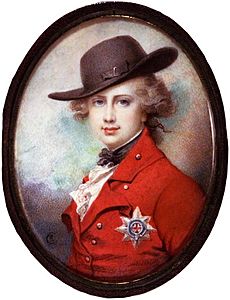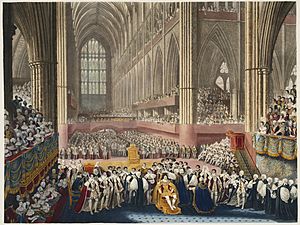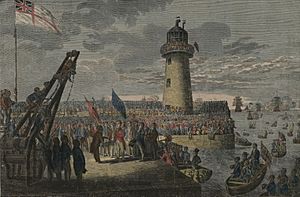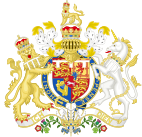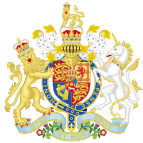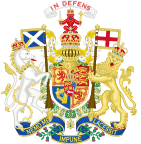George IV facts for kids
Quick facts for kids George IV |
|||||
|---|---|---|---|---|---|
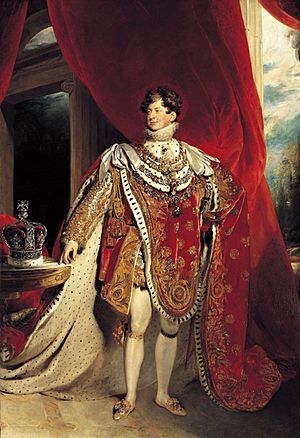
Coronation portrait by Thomas Lawrence, 1821
|
|||||
| King of the United Kingdom and Hanover (more...) | |||||
| Reign | 29 January 1820 – 26 June 1830 | ||||
| Coronation | 19 July 1821 | ||||
| Predecessor | George III | ||||
| Successor | William IV | ||||
| Prince Regent of the United Kingdom | |||||
| Regency | 5 February 1811 – 29 January 1820 | ||||
| Monarch | George III | ||||
| Born | 12 August 1762 St James's Palace, London, England |
||||
| Died | 26 June 1830 (aged 67) Windsor Castle, Berkshire, England |
||||
| Burial | 15 July 1830 Royal Vault, St George's Chapel, Windsor Castle |
||||
| Spouse | |||||
| Issue | Princess Charlotte of Wales | ||||
|
|||||
| House | Hanover | ||||
| Father | George III | ||||
| Mother | Charlotte of Mecklenburg-Strelitz | ||||
| Religion | Protestant | ||||
| Signature |  |
||||
George IV (born George Augustus Frederick; 12 August 1762 – 26 June 1830) was the King of the United Kingdom of Great Britain and Ireland and King of Hanover. He became king on 29 January 1820, after his father, King George III, passed away. Before becoming king, he served as Prince Regent from 1811 because his father was unwell.
George IV was the oldest child of King George III and Queen Charlotte. He was known for his very fancy lifestyle, which set many trends during the Regency era. He loved new forms of entertainment, fashion, and art. He hired famous architects like John Nash to build the amazing Royal Pavilion in Brighton. He also had Nash remodel Buckingham Palace and Jeffry Wyatville rebuild Windsor Castle.
People called him "the first gentleman of England" because he was charming and cultured. However, his spending habits and difficult relationships with his parents and wife, Caroline of Brunswick, made him unpopular. He even tried to divorce his wife, Caroline, which was a big scandal.
His time as ruler was marked by financial problems and disagreements. His ministers often found him to be selfish and unreliable. For most of his time as Regent and King, Lord Liverpool was the Prime Minister of the United Kingdom. Liverpool's government helped Britain win against Napoleon I. Later, George IV had to accept Catholic emancipation, which meant giving more rights to Roman Catholics, even though he didn't want to.
George's only child, Princess Charlotte, died before him in 1817. His younger brother, Prince Frederick, also passed away in 1827 without children. So, when George IV died, his next younger brother, William IV, became king.
Contents
Early Life and Becoming a Prince
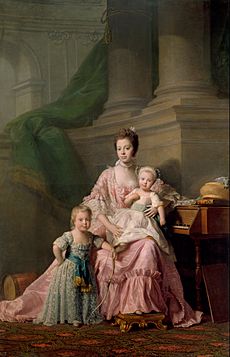
George was born at St James's Palace in London on 12 August 1762. He was the first child of King George III and Charlotte of Mecklenburg-Strelitz. Because he was the oldest son of the British ruler, he automatically became Duke of Cornwall and Duke of Rothesay at birth. A few days later, he was also named Prince of Wales and Earl of Chester.
George was a very smart student. He quickly learned to speak French, German, and Italian, besides his native English.
Life as a Young Prince
When George turned 18, he got his own household. Unlike his quiet father, George loved a life of fun and luxury. He was a great talker and had expensive taste in decorating his home.
When he turned 21 in 1783, Parliament gave him £60,000. He also received £50,000 each year from his father. But this was not enough for his lifestyle. For example, his horse stables alone cost £31,000 a year. He lived in Carlton House and spent a lot of money.
This caused problems between George and his father. The King wanted George to spend less. The King was also upset because George supported politicians like Charles James Fox.
Soon after turning 21, George fell in love with Maria Fitzherbert. She was not from a royal family, was six years older than him, and had been married twice before. She was also a Roman Catholic. George wanted to marry her, even though it was against the law. The Act of Settlement 1701 said that a royal who married a Catholic could not become king. Also, the Royal Marriages Act 1772 said he needed the King's permission to marry.
Despite these laws, George and Maria had a secret wedding ceremony on 15 December 1785. Legally, this marriage was not valid because the King did not approve it. However, Maria believed she was his true wife in the eyes of the Church. For political reasons, their marriage was kept secret.
Dealing with Debt
George's expensive lifestyle led him into huge debt. His father refused to help him. This forced George to leave Carlton House and live at Maria Fitzherbert's home.
In 1787, George's political friends tried to get Parliament to help pay his debts. But people suspected his secret marriage to Maria. If it became public, it would cause a huge scandal and ruin any chance of getting money. So, George's friend, Charles James Fox, publicly said the rumors were false. Maria was upset by this public denial. George then had another friend, Richard Brinsley Sheridan, explain it more carefully. Parliament eventually gave George £161,000 to pay his debts and £60,000 for improvements to Carlton House.
The King's Health and the Regency Crisis
In 1788, King George III's mental health became very poor. He could not perform his duties as king. This created a big problem for Parliament. Normally, Parliament could not start any work until the King gave a speech.
Parliament began to discuss who should rule if the King could not. Charles James Fox believed that the Prince of Wales should automatically take over. But the Prime Minister, William Pitt the Younger, argued that Parliament alone had the right to choose a regent. He said the Prince of Wales had no more right to rule than any other person without Parliament's approval. Even though they disagreed on the rules, both Pitt and Fox agreed that the Prince of Wales was the best choice for regent.
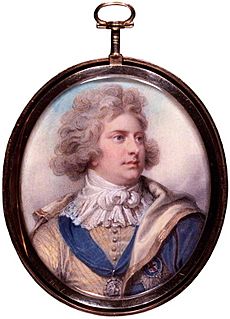
The Prince of Wales was annoyed by Pitt's strong words. But his brother, Prince Frederick, Duke of York and Albany, said George would not try to rule without Parliament's consent. Pitt then suggested that the Prince of Wales's powers as regent should be limited. For example, he would not be able to sell the King's property or create new noble titles. The Prince of Wales strongly disagreed with this plan.
To solve the problem, both sides agreed to a compromise. A special group of Lords Commissioners was appointed to formally open Parliament. This was unusual because the King usually did this. On 3 February 1789, Parliament was officially opened, and a bill for the regency was introduced. However, before it could be passed, the King recovered his health. The King then said that the actions taken by the Lords Commissioners were valid.
Marriage and Family Life
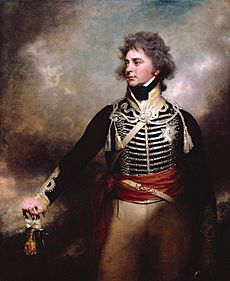
The Prince of Wales's debts kept growing. His father said he would only help if George married his cousin, Princess Caroline of Brunswick. In 1795, George agreed, and they married on 8 April 1795. However, their marriage was very unhappy. They were not suited for each other.
They formally separated after their only child, Princess Charlotte, was born in 1796. They remained separated for the rest of their lives. George remained close to Maria Fitzherbert for many years, even with some disagreements.
George was rumored to have had several children outside of his marriage. However, many of these claims have been proven false by historians.
Parliament helped George with his debts again. In 1795, his debts were £630,000. Parliament gave him an extra £65,000 each year. In 1803, another £60,000 was added. His debts from 1795 were finally paid off by 1806.
In 1804, there was a disagreement about who should care for Princess Charlotte. She was placed in the King's care. There was also an investigation into Princess Caroline's behavior after George accused her of having an illegitimate son. The investigation found Caroline innocent of the charge, but it did show that she had acted carelessly.
Becoming Prince Regent
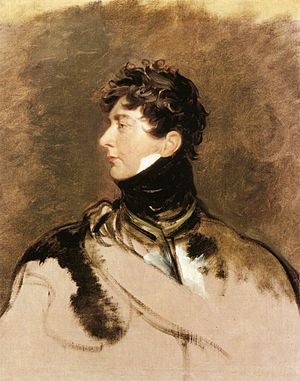
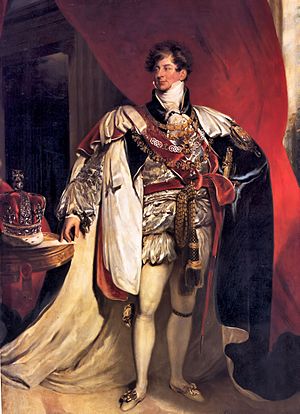
In late 1810, King George III's mental health worsened again after his youngest daughter, Princess Amelia, died. Parliament decided to follow the same plan as before. Without the King's permission, a special seal was placed on documents to name Lords Commissioners. These commissioners then approved a bill that became the Regency Act 1811. This law made the Prince of Wales the Prince Regent starting on 5 February 1811.
As Regent, George let his ministers manage government affairs. He played a much smaller role than his father had. During this time, it became clear that the Prime Minister should be the person supported by Parliament, even if the King didn't personally favor them.
One major political issue was Catholic emancipation. This was a movement to give Roman Catholics more political rights. The Tories, led by Prime Minister Spencer Perceval, were against it. The Whigs supported it. At first, people expected the Prince of Wales to support the Whigs. However, he did not immediately put them in power. He said that suddenly removing the Tory government would harm the King's health.
In 1812, it seemed unlikely the King would recover. The Prince of Wales still did not appoint a Whig government. Instead, he asked the Whigs to join the existing Tory government. The Whigs refused because they disagreed on Catholic emancipation. So, the Prince of Wales reluctantly allowed Perceval to continue as Prime Minister.
On 11 May 1812, Prime Minister Perceval was assassinated. The Prince Regent was ready to reappoint all the same ministers. But Parliament wanted a "strong and efficient administration." So, the Prince Regent offered the government leadership to Lord Wellesley and then to Lord Moira. However, he made it difficult for them to succeed by forcing them to create a government with both parties, which neither party wanted. The Prince Regent then reappointed the previous ministers, with Lord Liverpool as Prime Minister.
The Tories, unlike the Whigs, wanted to continue the war against Napoleon I in Europe. An alliance of countries, including Britain, defeated Napoleon in 1814. At the Congress of Vienna, it was decided that Hanover, which had shared a ruler with Britain since 1714, would become a kingdom. Napoleon returned from exile in 1815 but was defeated at the Battle of Waterloo by the Duke of Wellington.
During his time as Regent, George was very interested in style and design. His friends, like Beau Brummell and architect John Nash, helped create the Regency style. In London, Nash designed the beautiful buildings of Regent's Park and Regent Street. George also loved the idea of seaside resorts. He had the Brighton Pavilion built as a fantastical palace by the sea. Nash designed it in an "Indian Gothic" style, inspired by the Taj Mahal, with very fancy "Indian" and "Chinese" rooms inside.
Becoming King
When George III died in 1820, the Prince Regent, who was 57 years old, became King George IV. His powers did not really change.
By the time he became king, George IV's relationship with his wife, Caroline, was very bad. They had lived separately since 1796. In 1814, Caroline left the United Kingdom. But she decided to return for her husband's coronation. She wanted to publicly show her rights as queen consort. However, George refused to recognize her as queen. He even told British ambassadors to make sure other kings and queens in foreign countries did the same. Caroline's name was also left out of the official Church of England prayers.
The King wanted a divorce. He asked Parliament to introduce a special bill that would end his marriage and take away Caroline's title as Queen. This bill was very unpopular with the public and was eventually dropped. George still refused to let his wife attend his coronation at Westminster Abbey on 19 July 1821. Caroline became ill that day and died on 7 August. During her illness, she often said she thought she had been poisoned.
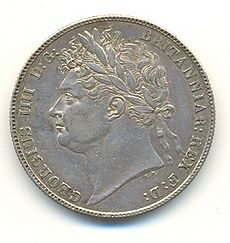
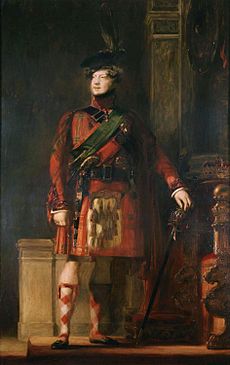
George's coronation was a grand and very expensive event. It cost about £243,000. For comparison, his father's coronation only cost about £10,000. Despite the huge cost, it was a popular event. In 1821, the King became the first monarch to visit Ireland in a long time. The next year, he visited Edinburgh in Scotland. His visit to Scotland, organized by Sir Walter Scott, was the first by a reigning monarch since the mid-1600s.
George spent most of his later reign living quietly at Windsor Castle. But he still got involved in politics. At first, people thought he would support Catholic emancipation. However, his anti-Catholic views became clear. He argued that he had sworn to uphold the Protestant faith during his coronation. So, he could not support any measures that helped Catholics.
In 1827, Prime Minister Liverpool retired. He was replaced by George Canning, who supported Catholic emancipation. When Canning took office, the King publicly stated that his feelings on the matter were the same as his father's.
Canning's views on Catholic emancipation were not popular with the most conservative Tories. So, his government had to include Whigs. Canning died later that year. Lord Goderich then led a weak government. Goderich left office in 1828. He was replaced by the Duke of Wellington. Wellington had by then accepted that some relief for Roman Catholics was necessary.
George was not as friendly with Wellington as he had been with Canning. Wellington had great difficulty getting the King's approval for a Catholic Relief Bill. The King's anti-Catholic brother, Ernest Augustus, Duke of Cumberland, pressured George to withdraw his approval. In protest, the government ministers resigned on 4 March. The next day, the King, under great political pressure, reluctantly agreed to the Bill. The government stayed in power. The Catholic Relief Act finally became law on 13 April.
Later Years and Passing Away
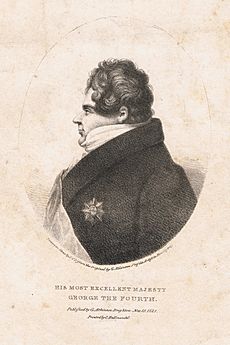
George's unhealthy lifestyle affected his health in his later years. He became very overweight. By 1797, he weighed over 245 pounds. By 1824, his waist was 50 inches. He suffered from gout (a painful joint condition), arteriosclerosis (hardening of arteries), and edema (swelling from fluid). In his last years, he spent whole days in bed and had trouble breathing.
George's final years were marked by his declining physical and mental health. He withdrew from public life. By December 1828, like his father, George was almost completely blind due to cataracts. He also had severe gout in his right hand and arm, making it hard to sign documents. In mid-1829, he was described as "wasting away frightfully." He had surgery for a cataract in September 1829.
By spring 1830, it was clear George was nearing his end. He was mostly confined to his bed. He had lost sight in one eye and described himself as "blind as a beetle." He had to approve laws by using a stamp of his signature. His weight was recorded to be over 280 pounds. Breathing problems forced him to sleep sitting up in a chair. Doctors often drained excess fluid from his body.
Despite his decline, George held onto life strongly. His will to live and his large appetite surprised people. In April 1830, the Duke of Wellington wrote that the King had a huge breakfast. George dictated his will in May. He became very religious in his last months. He confessed to a church leader that he regretted his past life. He hoped for mercy because he had always tried to do his best for his people.
On 26 June 1830, at about three in the morning, George awoke at Windsor Castle. He called for his doctor, Sir Henry Halford, saying, "Sir Henry! Sir Henry! Fetch him; this is death!" George died at 3:15 a.m. An autopsy showed he died from internal bleeding in his stomach. Doctors also found a large tumor near his bladder. His heart was enlarged and had a lot of fat around it.
The King was buried in St George's Chapel, Windsor Castle, on 15 July.
George IV's Legacy and Impact
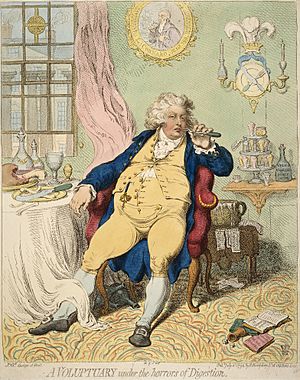
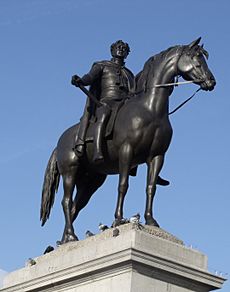
George's only legitimate child, Charlotte, died in 1817. George III's second son, Prince Frederick, Duke of York and Albany, died without children in 1827. So, the throne went to George III's third son, Prince William, Duke of Clarence, who became William IV.
George was called the "First Gentleman of England" because of his style and manners. He was smart, clever, and knowledgeable. But his laziness and overindulgence meant he didn't use his talents fully. One newspaper wrote that he would always prefer "a girl and a bottle to politics and a sermon."
The Regency period saw big changes in fashion, largely influenced by George. When a tax was put on wig powder, he stopped wearing powdered wigs. He wore darker colors because they helped hide his size. He also made trousers popular instead of knee breeches. He liked high collars with neck cloths to hide his double chin. His visit to Scotland in 1822 helped bring back Scottish tartan clothing.
The Duke of Wellington, who worked closely with George, had mixed feelings about him. He once called George "the worst man he ever fell in with his whole life." But in a speech after George's death, Wellington praised him as "the most accomplished man of his age." Wellington later said George was "a magnificent patron of the arts" and a mix of many different qualities, mostly good.
After George's death, a newspaper wrote that "There never was an individual less regretted by his fellow-creatures than this deceased king."
Many statues of George IV were built during his reign. One famous one is a bronze statue of him on horseback by Sir Francis Chantrey in Trafalgar Square, London.
In Edinburgh, "George IV Bridge" is a main street named after him. It was designed in 1829. King's Cross, a major transport hub in London, is also named after a monument built for George IV in the 1830s.
Titles, Styles, and Honors
Titles and Styles Held
When he was born, he was called Prince of Great Britain and Ireland, Electoral Prince of Brunswick-Lüneburg, and Duke of Rothesay. As regent, his official title was "Regent of the United Kingdom of Great Britain and Ireland."
Awards and Recognitions
- 26 December 1765: Royal Knight of the Garter
- 21 November 1783: Privy Counsellor
- 26 January 1789: Fellow of the Royal Society
- 2 May 1810: Doctor of Civil Law, University of Oxford
- 28 April 1818: Founder of the Most Distinguished Order of St Michael and St George
 Kingdom of Hanover: 28 April 1815: Founder of the Royal Hanoverian Guelphic Order
Kingdom of Hanover: 28 April 1815: Founder of the Royal Hanoverian Guelphic Order
International Honors
 Russian Empire:
Russian Empire:
- 25 November 1813: Knight of St. Andrew
- 20 April 1814: Knight of St. Alexander Nevsky
 Kingdom of Prussia: 11 April 1814: Knight of the Black Eagle
Kingdom of Prussia: 11 April 1814: Knight of the Black Eagle Kingdom of France: 20 April 1814: Knight of the Holy Spirit
Kingdom of France: 20 April 1814: Knight of the Holy Spirit Spain: 5 July 1814: Grand Cross of the Order of Charles III
Spain: 5 July 1814: Grand Cross of the Order of Charles III Kingdom of Portugal: 7 April 1815: Grand Cross of the Sash of the Three Orders
Kingdom of Portugal: 7 April 1815: Grand Cross of the Sash of the Three Orders Austrian Empire:
Austrian Empire:
- 8 June 1815: Knight of the Golden Fleece
- 1819: Grand Cross of St. Stephen
 Denmark: 4 July 1815: Knight of the Elephant
Denmark: 4 July 1815: Knight of the Elephant Two Sicilies:
Two Sicilies:
- 1816: Knight of St. Januarius
- 1816: Grand Cross of St. Ferdinand and Merit
 Netherlands: 27 November 1818: Grand Cross of the Military William Order
Netherlands: 27 November 1818: Grand Cross of the Military William Order Kingdom of Bavaria: 1826: Knight of St. Hubert
Kingdom of Bavaria: 1826: Knight of St. Hubert
Military Roles
- 1782: Colonel, British Army
- 1796–1820: Colonel of the 10th Light Dragoons
Royal Coats of Arms
George's coat of arms as the Prince of Wales featured the royal arms. It had a special design to show his rank. His arms changed in 1801 when the French part was removed.
As king, his arms combined the symbols of his two kingdoms: the United Kingdom and Hanover. It showed three lions for England, a lion for Scotland, and a harp for Ireland. It also included symbols for Brunswick, Lüneburg, and Westphalia for Hanover.
Images for kids
Error: no page names specified (help). In Spanish: Jorge IV del Reino Unido para niños
In Spanish: Jorge IV del Reino Unido para niños


